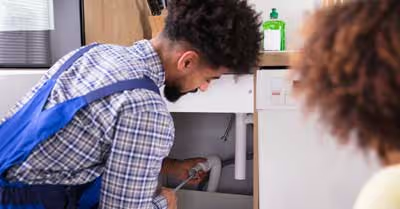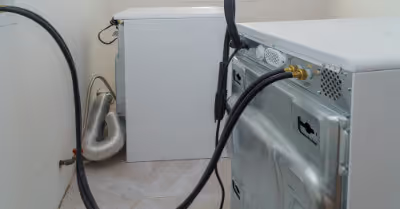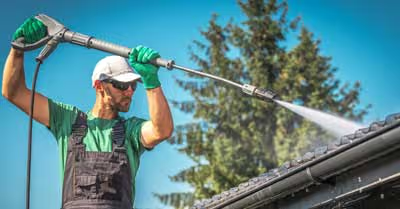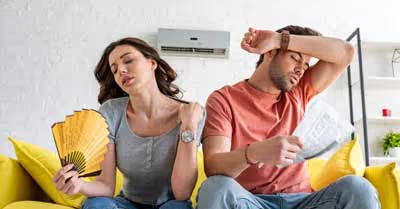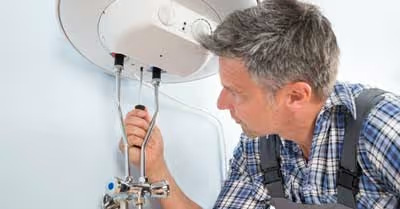Table of Contents
Central Home Air Conditioner: What You Should Know
If your house has a central air conditioning system, that is experiencing some problems, considering getting your hands on to it. To get a professional to fix them, you might have to wait for days and stay in the heat before the technician shows up. And when he does come, be prepared to pay a considerable sum for the repairs.
If you are comfortable working with electricity, you can save some money repairing your cooling system yourself. All you need to do will be to buy new parts or follow this essential guide to learn about the best tips for DIY air conditioner repair.
When you are dealing with issues of "no cooling" or "low cooling," all you need to have on hand are some insulated screwdrivers, a socket set, and a voltage snipper.
Of course, if you don't manage to fix the problems with the following repair tips, you should be contacting a professional, who will most probably know how to solve the issue.
Before getting serious about repairing your cooling system, you should be familiar with what makes a central home conditioner service system.
Let's start with its anatomy. Such an air conditioner consists of two components: a condensing unit that sits outdoors, outside your house, and an evaporator coil, located in your furnace or the air handler. The system is rather simple: the refrigerant in the evaporator takes the warm air in your house and moves it outdoors to the condensing unit. The part located outside blows the air and removes the internal heat. The condenser consists of three sections that you could easily replace in case of issues: the capacitors, the AC contactor, and the fan motor. If the problems come from the evaporator coil, unfortunately, you won't be able to repair it yourself.
How To Repair an Air Conditioner
Before doing anything on your cooling system, make sure you've turned the power off in the main electrical panel. To safely ensure that the power is off, it can be a good idea to use a voltage tester on the wires that are coming into the contactor.
As mentioned, this guide focuses on solving issues on the condenser unit of your cooling system, the one located outside your home. We will touch upon other kinds of problems as well, but not as in-depth.
While other parts making up the condenser are rather cheap to change, the motor of the unit is an expensive piece that can cost you around $150. Double-check the failure is coming from there before setting your way off to replace it.
When Is It Time To Buy New Parts
As mentioned before, buying parts can save you lots of money in repairs. But when it is time to buy new parts and most importantly, how can you do it?
Before we start, it is good to mention that the AC contactor and the capacitors for start/run are the parts that tend to fail the most in a cooling system. Luckily, they are also the cheapest ones to replace. If you notice a fail in the relay or the capacitors, it is good practice to buy and install new parts right away. That is especially true for air conditioners that are about five years or older.
No matter what kind of part you are looking to replace, to buy pieces, you'll need to find the nameplate on the unit, as well as the serial number and its model. To make things simpler, you can just take a picture of the part you want to replace and take it to an appliance store or look for it online.
Check the Furnace
One of the first steps you should follow when learning how to repair an air conditioner is to check the furnace. Before anything else, if something seems to be off with your cooling system, you should set your thermostat to AC mode and lower the temperature. If you hear the furnace fan turning on, the furnace has nothing to do with the issue. On the contrary, if the fan doesn't work, a good idea would be to reset the whole circuit breaker.
Also, make sure you check the outside condensing unit, where both the compressor and the fan should be running. If you don't hear a refrigerator sound (from the compressor) and the fan is not running, keep reading to find out how to repair an air conditioner.
If even with a reset, the fan doesn't start, it is best to call a professional, as you won't be able to solve the issue with any of the tips provided in this guide.
If The AC Is Not Cooling Properly or Not Working
When you notice little to no cold air is coming from your AC, or you think the system is failing to work, start with some of the following easy fixes before getting to the hard stuff.
For instance, you need to check whether all the registers in the house are open. Any obstructions can cause your air conditioning system to fail. Once ensured the lack of objects or dirt getting in the way of the registers, it is time to control the furnace filters: they must be clean and free of debris or dust.
If you noticed several closed registers or a dirty and clogged filter, the cause of no cooling from your air conditioner is probably the reduced airflow. When you are still having problems even with a clean filter, with all registers being free from obstructions, the problem might come from the A-coil.
One of the first things you should try in such cases is to defrost the evaporator (also referred to as A-coil). To do so, simply switch the thermostat from the "cooling" mode to "Off" and move the fan switch from "auto" to "on." The blower should run for at least 30 minutes or until you feel good airflow coming from the registers.
To test whether you've been successful at DIY repairing your air conditioning system, turn the AC back on. When the cooling system works for 12 hours straight, you can be safe knowing that you've solved the issue.
Clogged condenser coils can cause the compressor to shut down due to overheating and extreme pressure. When you experience intermittent periods of minimal cooling followed by a failing AC service system, the problem is most probably coming from clogged coils. No matter how clean you think they are, you might have to clean them again if the AC doesn't seem to work.
Cleaning the Condenser Coils
To correctly clean the condenser coils and avoid functional issues with your AC, you need to turn the power off. Consequently, turn off the breakers controlling AC service and the furnace circuit in your main electrical panel. Then, you must turn off even the power switch at the furnace. Take away a part of the condenser called the "disconnect block" and clean the coils. You can do so with your garden nozzle aimed upwards into the top of the condenser coils to remove any dirt that might have accumulated under the lid. Keep working your way around the loop down till the end.
To end with, use a gentle stream of water coming from your garden nozzle, and shoot it directly into the coils: it will help you remove any remaining debris.
After a thorough cleaning session, with new filters and open vents, the AC should operate normally. If that is not the case, keep reading the next sections: they might help you to find other possible fixes to your problems.
You Might Have To Test The Fuses
When your cooling system is not functioning correctly, check whether all the fuses are in good condition. As soon as you find blown or discolored fuses, you can be sure there is something wrong inside the condensing unit.
Mind you: you won't solve the problem by simply replacing the fuse with a new one. Instead, you'll also have to purchase a new disconnect block, and even some cartridge fuses to fire the unit up.
To check the fuses' conditions, grab a multimeter, and set it to the lowest Ohms scale. Touch the black and red leads to opposite ends of each fuse. As soon as you get a numerical reading, your fuse is good. On the other hand, if you read a zero, a minus, or an infinity symbol, the fuse is blown and should be replaced.
If you are still having problems with your AC, even after a DIY air conditioner repair, call a professional, as you most probably have much more concerning issues that you won't be able to fix yourself.
Inspect The Access Panel
In the electrical conduit of your house, you'll find the access panel. Don't forget the power must be turned off before removing the screws that are holding the door together. Before thinking about replacing parts, look for chewing on wires and connections or rodents' nests. If you do find some chewed or broken wires, and you are familiar with handling electrical repairs, you can remove the capacitor. After that, repair anything that's broken and clean up the nest (if any). If you don't feel comfortable with such a task, call a professional: the right company will most definitely know how to handle the problem.
You Might Have To Replace An Old Dual Start/Run Capacitor
No matter the type of AC system you have in your house, all air conditioning units include at least one capacitor. Such a part's purpose is to store the electricity that will be released during compression and condensation by the fan. Capacitors give both motors extra energy to start. On top of that, they smooth out the voltage fluctuations, which protects both engines and prevents them from getting damaged.
The downside of capacitors is that they tend to degrade. With time, they will provide less energy for the motors to start up, which will affect the overall efficiency of the system. Also, they might fail gradually, without you noticing it. Such failures are dangerous, as they put the compressor and condenser fan motors into a lot of stress, which will cause early failure in the whole system.
The good news is that capacitors are rather cheap, so to avoid you expensive repairs and replacements, make sure you proactively replace them at least every five years.
For how complicated as it might sound, the process of replacing a capacitor is no rocket science. What you need to remember is taking a photo of the wires before disconnecting something, as it will serve you as a reference later in the process. Discharge the stored energy in the old capacitor using needle-nose pliers (you'll have a more detailed explanation of the process in the next section). Such instruments will help you pluck one wire at the time from the old unit and add it to the corresponding part in the new capacitor.
Ensure you tightly place the connectors where they should be. As a rule of thumb, if you can wiggle them, remove the connector and bend its edges, to better fit it on the tab. When you've changed all the wires to the new capacitor, slide it into the retaining bracket and tighten the screw. For a cleaner job, secure the cables with a zip tie. With all of that done, you are good to go!
How To Discharge A Capacitor
Before replacing an old capacitor, you must discharge it. The process is not complicated: remove the capacitor from the retaining bracket. With an insulated screwdriver, touch between the H (for HERM) and C (for COMMON) terminal. Follow the same procedure for the F (for FAN) and the C terminal. If your capacitor is single-mode, make a short between the two terminals.
You Might Have To Replace The AC Contractor
AC contactors use power from the thermostat to switch the current to the compressor and the condenser. Unfortunately, they tend to wear out quickly. For this reason, they are the cause of some of the most common air conditioning failures. Even when you think the contractor is working correctly, it is a good idea to replace it from time to time.
To place a new contactor in the AC system, unscrew the old one before removing the wires, take a picture of the order of the cables to use it as a reference, and move them to the corresponding section in the new unit.
You might have to tighten the connection to hold the contractor in place. Secure it with its screws in the condensing unit to terminate the job.
How To Test Your Repairs
If you've tried to solve the issues with your AC system using the tips provided in this guide, you'll want to test whether you've learned how to repair an air conditioner. To check whether your repair was successful, reinstall the access panel and turn on the circuit breaker and the furnace switch. Set the system's temperature to a low one and wait for the AC to start. Don't forget to be patient at the startup, as AC units and thermostats come with so-called delay features that get activated when they are shut down and turn on again. You can expect the delay to be as long as 10 minutes. Additionally, if you have any sort of energy-saving device, the unit will most probably take even longer to turn on again.
As soon as the compressor starts to run and you hear the fan spinning, it is the sign you've been a pro at repairing your AC service system! Otherwise, if the compressor does start but not the fan, the problem has to do with the fan motor. To solve the issue, shut the power off again and take away the cover on the condenser using a screwdriver. Remove the fan blade and the motor and try to reinstall them. To help you in the process, you must mark the piece to identify which side should be up. Use a set of screwdrivers to loosen the blade and pull it off the motor. Add the new equipment in the space and replace it with the old one. Make sure you direct the wires through the old conduit. Secure the cables with zip ties. You must not have any loose wire hanging, as the blade might cut them, causing troublesome problems.
When you are done with that, secure the cover with its screws and power up the unit once again.
If the unit doesn't fire up after 30 minutes and you've moved the thermostat to AC mode and lowered the temperature, you must call a professional to fix the issue.
More Tips About Detecting Any Possible Issues Your AC System Might Have
On top of what we mentioned throughout the guide, here are more problems that you might want to address before blaming it on the AC system.
Check Whether Your AC is getting Direct Light
If you can, try to move your cooling system to a shady spot, or it will have to work harder to cool down your rooms. If transferring the AC is not possible, keep curtains drawn during the day to block the sun from coming into your house and heating it. Also, you should ensure hot air is not getting in (or that cold air doesn't seep out with the AC on). You might want to reseal around your unit with stripping. Keep in mind that even if most new windows come equipped with insulation panels, you'll still need to apply weather stripping around the plastic side panels to maximize their efficiency.
What Kinds Of Noises Is Your AC Making?
It is no news: one of the downsides of air conditioners is the noise they are known to be making. When owning an AC system, you should get accustomed to the sound of the spinning fan and the compressor cycling on and off. Certain kinds of noises should not be of concern. However, you must learn how to identify the normal sounds to the unusual ones, as they might help you detect any abnormalities in your cooling system. Weird noises are one of the easiest ways to check whether there is something wrong with your cooling system. Some sounds are nothing to worry about, but if you own your AC for years, you should be used to them. As soon as you hear some kind of noise that deviates from the norm, you should start to take action.
For instance, if you hear vibrating sounds, they might be signaling a faulty installation of the unit. Check with the instructions' manual to confirm you've followed all the correct steps to install the AC service system. Your cooling system must be securely sitting in the window without vibrating.
When the fan motors start making more noise than usual, the cause might be accumulated debris or dirt, as well as deteriorating bearings and worn out belts.
As a rule of thumb, check for other unusual and loud sounds: you'll need to take care of them as soon as possible if you want to avoid the problems to get harder to solve in the future.
When Some Rooms Are Warmer Than Others
Improper airflow through your ducts might cause warmer air to come out, failing to cool your house. The problem here might be caused by leaking or dirty ducts. As the ductwork running through the walls and ceiling of your home might easily tear up as the results of rodents or inattentive workers, doing some regular inspection might be a good idea. Leaky air ducts will cause the entire home to feel warmer, which will not only put a lot of stress into your AC system but also increase your electricity bills at the end of the month.
Recent Articles



